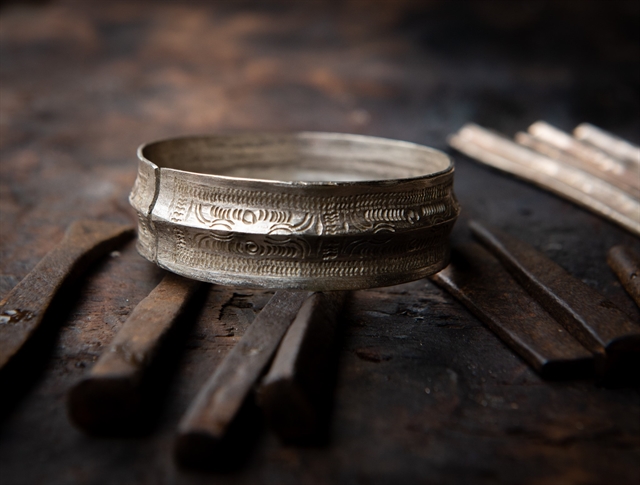In Nùng tradition, silver is a sacred material thought to possess talismanic qualities that can exorcise evil, prevent "poisonous winds", protect health, bring happiness, as well as protect the soul.

Ethnic women are trading silver products at the district market. VNA/VNS Photo Nam Thái
Silver and silver jewellery are an indispensable part of the cultural and spiritual life of the Nùng, an ethnic minority in the northern mountain province of Hà Giang's Hoàng Su Phì District.
In Nùng tradition, silver is a sacred material thought to possess talismanic qualities that can exorcise evil, prevent "poisonous winds", protect health, bring happiness, as well as protect the soul. If a Nùng does not wear silver, he or she may forget his or her origins and ancestors, according to tradition.

A Nùng artisan uses special tools to meticulously carve silver following traditional methods. VNA/VNS Photo Nam Thái
Trần Chí Nhân, deputy head of Hoàng Su Phì Department of Culture and Information, says legend has it that the Nùng people were wealthy and strong in the past.
Their lives were prosperous and happy until a Han King suddenly sent troops to invade the land and plunder their wealth.
To defend their land, young Nùng men joined the army to fight the Han invasion. However, the enemy was cruel and tortured the local women, forcing them to wear stone mortars on their back, piercing silver needles into their heads, and tying iron chains around their necks and wrists.

Silver products by Nùng artisans are not only preferred in local community but are also available in all markets in Hoàng Su Phì District. Many of them are sold at a high price bringing income to the jewelers and their family. VNA/VNS Photo Nam Thái
Many days passed, despite the weight of the stone mortars and iron chains on the women's backs, they suffered without crying or complaining, waiting for their husbands to come and save them.
The loyalty and faithfulness of the Nùng women finally reached the Han King. He had such a deep respect for them, he withdrew all of his soldiers and ended the war.
Nùng women today wear silver jewels such as necklaces, chains and bracelets as a way to make the younger generation understand and remember difficult days from the past.
Nhân says that to create a piece of silver jewellery, Nùng silver carving artisans have to choose high-quality raw materials, and use hand tools such as scissors, pliers, hammers, wooden bases, and melting pots.
"Many of them have crafted unique silver pieces with delicate patterns. It is very much part of their life," he adds.
According to the artisans, the silver carving is a very meticulous work. A good worker must be very patient because the crafting process requires ingenuity and perseverance.

A typical silver bracelet of the Nùng people in Hòang Su Phì, Hà Giang Province. VNA/VNS Photo Nam Thái
Artisan Nùng Văn Húi from Pờ Ly Ngài Commune has worked in silver carving for more than 30 years and learned about the craft from when he was very young.
"To create a silver product, an artisan should be skilful to experience the various stages such as melting the silver, pouring it into a tray, continuing to heat to laminate it, then using special tools to delicately chisel and carve. After such stages, engraved silver bar will be bent, washed and polished to make the perfect product," Húi says.
He says there are currently not many silver carving artisans in the locality, and he is trying to pass the craft on to his son as a way to help preserve the traditional occupation.
"Hopefully, the craft will continue to be preserved by the young generation as a precious artistic cultural aspect of the Nùng people," he says.
The silver products of the Nùng are prominent because of their delicate and diverse designs.
They are not only consumed in their community but also in other markets in Hoàng Su Phì. Many of them sell at a high price, bringing income to silver jewelers and their family.
The Nùng has a long history and makes up the largest ethnic group in Hoàng Su Phì, accounting for over 38 per cent of the district's population, living in 11 of 25 communes and towns. Although cultural mixing among ethnic groups is becoming more and more popular, the group still retains many unique cultural features, contributing to the rich and diverse culture of the highland.
The silver carving of the Nùng in Pờ Ly Ngài and Nàng Ðôn communes has been included in the list of national intangible cultural heritage since 2019, according to the Ministry of Culture, Sports and Tourism. VNS